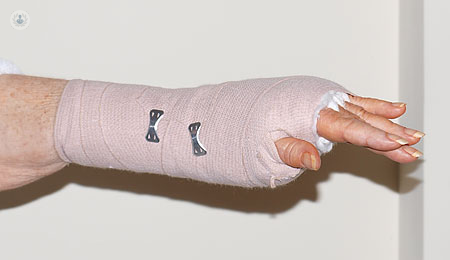Wrist surgery
Mr Andrew Fitzgerald - Orthopaedic surgery
Created on: 05-03-2018
Updated on: 04-25-2023
Edited by: Conor Dunworth
What is wrist surgery?
There are many types of surgical procedures that can be performed on the wrist, depending on the injury or condition being treated. These include both open and minimally invasive surgery on the bones, tendons, ligaments, and nerves in the wrist. As is often the case, surgery is usually only recommended by your doctor in serious situations, or when more conservative treatment has not worked.

Why would you have wrist surgery?
There are many things that can happen to your wrist that can warrant surgery. Generally, these are either injuries to the bones, ligaments, or nerves, or serious medical conditions that cause pain or affect the patient’s quality of life. Surgery may be recommended for the following:
- Broken/fractured wrist – some breaks and fractures may require procedures such as a wrist arthroscopy, while others may require stabilisation via a bone graft. Open fractures that breach the skin may require surgery immediately.
- Arthritis – while there is no cure, some surgical interventions, such as wrist fusions can reduce pain and increase strength.
- Carpal tunnel syndrome – surgery can release the pressure on the trapped median nerve.
In most cases, the doctor will only advise surgery if other treatment options have failed.
What does wrist surgery involve?
Different types of wrist surgery involve different things:
- Surgical fusion – by fusing bones together, it can make the wrist stronger and reduce pain, for example, caused by arthritis. However, it severely reduces movement at the joint.
- Bone graft – new bone material taken from elsewhere in the patient’s body may be needed to stabilise a fracture.
- Metal implants, such as pins, a plate, or an external fixator frame can be fixed to broken bones to stabilise them and help them to heal in the optimal way.
- Arthroscopic wrist surgery is a minimally invasive procedure using a small camera called an arthroscope to guide the surgeon in using tiny surgical instruments inserted into the wrist via a small incision.
- Ligament surgery
- Tendon transfer
- Surgery for carpal tunnel can involve splitting the transverse carpal ligament, removing cysts, cutting tendons, and removing old scar tissue to open up the corridor inside the wrist and release the pressure on the median nerve.
















